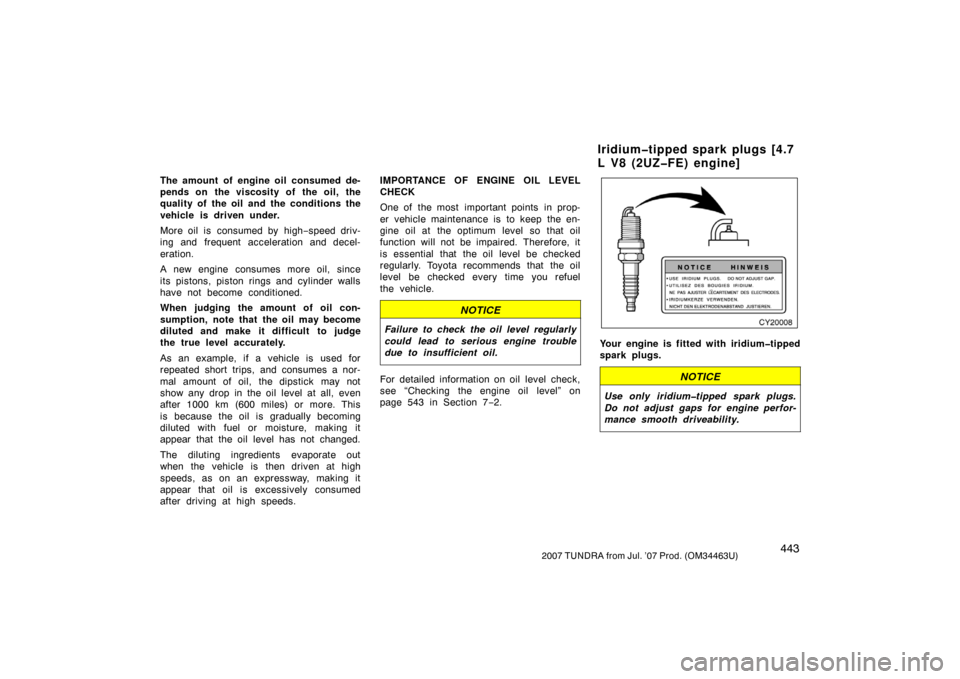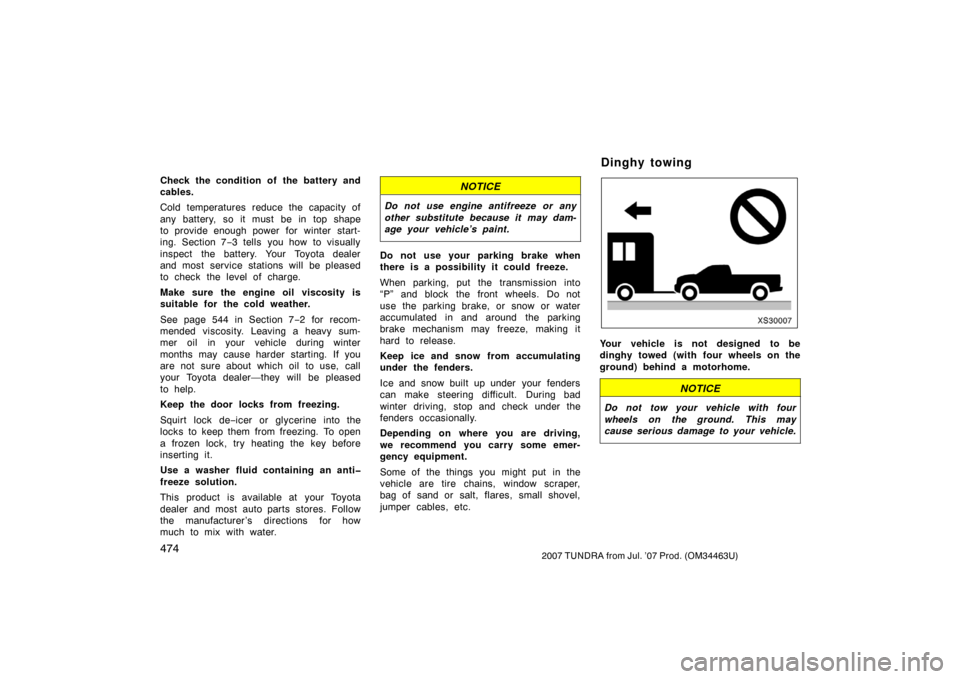Page 452 of 611

4432007 TUNDRA from Jul. ’07 Prod. (OM34463U)
The amount of engine oil consumed de-
pends on the viscosity of the oil, the
quality of the oil and the conditions the
vehicle is driven under.
More oil is consumed by high−speed driv-
ing and frequent acceleration and decel-
eration.
A new engine consumes more oil, since
its pistons, piston rings and cylinder walls
have not become conditioned.
When judging the amount of oil con-
sumption, note that the oil may become
diluted and make it difficult to judge
the true level accurately.
As an example, if a vehicle is used for
repeated short trips, and consumes a nor-
mal amount of oil, the dipstick may not
show any drop in the oil level at all, even
after 1000 km (600 miles) or more. This
is because the oil is gradually becoming
diluted with fuel or moisture, making it
appear that the oil level has not changed.
The diluting ingredients evaporate out
when the vehicle is then driven at high
speeds, as on an expressway, making it
appear that oil is excessively consumed
after driving at high speeds. IMPORTANCE OF ENGINE OIL LEVEL
CHECK
One of the most important points in prop-
er vehicle maintenance is to keep the en-
gine oil at the optimum level so that oil
function will not be impaired. Therefore, it
is essential that the oil level be checked
regularly. Toyota recommends that the oil
level be checked every time you refuel
the vehicle.
NOTICE
Failure to check the oil level regularly
could lead to serious engine trouble
due to insufficient oil.
For detailed information on oil level check,
see “Checking the engine oil level” on
page 543 in Section 7
−2.
CY20008
Your engine is fitted with iridium�tipped
spark plugs.
NOTICE
Use only iridium�tipped spark plugs.
Do not adjust gaps for engine perfor-
mance smooth driveability.
Iridium�tipped spark plugs [4.7
L V8 (2UZ�FE) engine]
Page 482 of 611

4732007 TUNDRA from Jul. ’07 Prod. (OM34463U)
NOTICE
�If driving through water, such as
when crossing shallow streams,
first check the depth of the water
and the bottom of the river bed for
firmness. Drive slowly and avoid
deep water.
� Take all necessary safety measures
to ensure that water damage to the
engine or other components does
not occur.
� Water entering the engine air intake
will cause severe engine damage.
� Water entering the automatic trans-
mission will cause deterioration in
shift quality, locking up of your
transmission accompanied by vibra-
tion, and ultimately damage.
� Water can wash the grease from
wheel bearings, causing rusting and
premature failure, and may also en-
ter the differentials, transmission
and transfer case, reducing the gear
oil’s lubricating qualities.
�Sand and mud that has accumulated
in brake drums and around brake
discs may affect braking efficiency
and may damage brake system com-
ponents.
� Always perform a maintenance in-
spection after each day of off�road
driving that has taken you through
rough terrain, sand, mud, or water.
For scheduled maintenance in-
formation, refer to the “Scheduled
Maintenance Guide” or “Owner’s
Manual Supplement”.Make sure your coolant is properly pro-
tected against freezing.
Only use “Toyota Super Long Life Coolant”
or similar high quality ethylene glycol
based non −silicate, non −amine, non− nitrite,
and non −borate coolant with long −life hy-
brid organic acid technology. (Coolant with
long −life hybrid organic acid technology is
a combination of low phosphates and or-
ganic acids.)
See “Checking the engine coolant level”
on page 546 in Section 7 −2 for details of
coolant type selection.
For the U.S.A.—“Toyota Super Long Life
Coolant” is a mixture of 50% coolant and
50% deionized water. This coolant pro-
vides protection down to about −35 �C
( − 31 �F).
For Canada—“Toyota Super Long Life
Coolant” is a mixture of 55% coolant and
45% deionized water. This coolant pro-
vides protection down to about −42 �C
( − 44 �F).
NOTICE
Do not use plain water alone.
Winter driving tips
Page 483 of 611

4742007 TUNDRA from Jul. ’07 Prod. (OM34463U)
Check the condition of the battery and
cables.
Cold temperatures reduce the capacity of
any battery, so it must be in top shape
to provide enough power for winter start-
ing. Section 7−3 tells you how to visually
inspect the battery. Your Toyota dealer
and most service stations will be pleased
to check the level of charge.
Make sure the engine oil viscosity is
suitable for the cold weather.
See page 544 in Section 7 −2 for recom-
mended viscosity. Leaving a heavy sum-
mer oil in your vehicle during winter
months may cause harder starting. If you
are not sure about which oil to use, call
your Toyota dealer—they will be pleased
to help.
Keep the door locks from freezing.
Squirt lock de −icer or glycerine into the
locks to keep them from freezing. To open
a frozen lock, try heating the key before
inserting it.
Use a washer fluid containing an anti�
freeze solution.
This product is available at your Toyota
dealer and most auto parts stores. Follow
the manufacturer ’s directions for how
much to mix with water.NOTICE
Do not use engine antifreeze or any
other substitute because it may dam-
age your vehicle’s paint.
Do not use your parking brake when
there is a possibility it could freeze.
When parking, put the transmission into
“P” and block the front wheels. Do not
use the parking brake, or snow or water
accumulated in and around the parking
brake mechanism may freeze, making it
hard to release.
Keep ice and snow from accumulating
under the fenders.
Ice and snow built up under your fenders
can make steering difficult. During bad
winter driving, stop and check under the
fenders occasionally.
Depending on where you are driving,
we recommend you carry some emer-
gency equipment.
Some of the things you might put in the
vehicle are tire chains, window scraper,
bag of sand or salt, flares, small shovel,
jumper cables, etc.XS30007
Your vehicle is not designed to be
dinghy towed (with four wheels on the
ground) behind a motorhome.
NOTICE
Do not tow your vehicle with four
wheels on the ground. This may
cause serious damage to your vehicle.
Dinghy towing
Page 514 of 611
5052007 TUNDRA from Jul. ’07 Prod. (OM34463U)
CAUTION
Never use oil or grease on the
bolts or nuts. The nuts may loose
and the wheels may fall off,
which could cause a serious ac-
cident.
XS40016b
Rear
Front
4. Position the jack at the correct
jack point as shown.
Make sure the jack is positioned on
a level and solid place.
JACK POINTS:
Front—Under the frame side rail
Rear—Under the rear axle housing
XS40007
Put a wheel nut wrench, jack handle
extension and jack handle end togeth-
er as shown in the illustration.
1 Jack handle end
2 Jack handle extension No.1
3 Jack handle extension No.2
4 Wheel nut wrench
CAUTION
Make sure they are each securely
fixed.
—Positioning the jack
Page 539 of 611

5302007 TUNDRA from Jul. ’07 Prod. (OM34463U)
What about do�it�yourself maintenance?
Many of the maintenance items are easy
to do yourself if you have a little mechani-
cal ability and a few basic automotive
tools. Simple instructions for how to per-
form them are presented on page 535 in
Section 7.
If you are a skilled do−it−yourself
mechanic, the Toyota service manuals are
recommended. Please be aware that
do− it−yourself maintenance can affect your
warranty coverage. See “Owner ’s Warranty
Information Booklet” or “Owner ’s Manual
Supplement” for the details. Listed below are the general maintenance
items that should be performed as fre-
quently as specified. In addition to check-
ing the items listed, if you notice any
unusual noise, smell or vibration, you
should investigate the cause or take your
vehicle to your Toyota dealer or a quali-
fied service shop immediately. It is recom-
mended that any problem you notice be
brought to the attention of your dealer or
the qualified service shop for their advice.
CAUTION
Make these checks only with ade-
quate ventilation if you run the en-
gine.
IN THE ENGINE COMPARTMENT
Items listed below should be checked
from time to time, e.g. each time when
refueling.
Washer fluid
Make sure there is sufficient fluid in the
tank. See page 563 in Section 7
−3 for
additional information. Engine coolant level
Make sure the coolant level is between
the “FULL” and “LOW” lines on the see
−
through reservoir when the engine is cold.
See page 546 in Section 7 −2 for addition-
al information.
Radiator, condenser and hoses
Check that the front of the radiator and
condenser are clean and not blocked with
leaves, dirt, or insects. See page 547 in
Section 7 −2 for additional information.
Battery condition
Check the battery condition by the indica-
tor color. See page 560 in Section 7 −3 for
additional information.
Brake fluid level
Make sure the brake fluid level is correct.
See page 547 in Section 7 −2 for addition-
al information.
Engine oil level
Check the level on the dipstick with the
engine turned off and the vehicle parked
on a level spot. See page 543 in Section
7 −2 for additional information.
Power steering fluid level
Check the level through the reservoir. The
level should be in the “HOT” or “COLD”
range depending on the fluid temperature.
See page 548 in Section 7 −2 for addition-
al information.
General maintenance
Page 544 of 611
5352007 TUNDRA from Jul. ’07 Prod. (OM34463U)
1. Windshield washer fluid tank
2. Engine oil level dipstick
3. Engine coolant reservoir
4. Engine oil filler cap
5. Brake fluid reservoir
6. Fuse block
7. Battery
8. Radiator
9. Condenser
10. Power steering fluid reservoir
Engine compartment overview
� 4.0 L V6 (1GR�FE) engine
XS71001a
Page 545 of 611
5362007 TUNDRA from Jul. ’07 Prod. (OM34463U)
1. Windshield washer fluid tank
2. Engine oil level dipstick
3. Engine coolant reservoir
4. Engine oil filler cap
5. Brake fluid reservoir
6. Fuse block
7. Battery
8. Radiator
9. Condenser
10. Power steering fluid reservoir
�
4.7 L V8 (2UZ�FE) engine
XS71002a
Page 546 of 611
5372007 TUNDRA from Jul. ’07 Prod. (OM34463U)
1. Windshield washer fluid tank
2. Engine oil level dipstick
3. Engine coolant reservoir
4. Engine oil filler cap
5. Brake fluid reservoir
6. Fuse block
7. Battery
8. Radiator
9. Condenser
10. Power steering fluid reservoir
�
5.7 L V8 (3UR�FE) engine
XS71003a